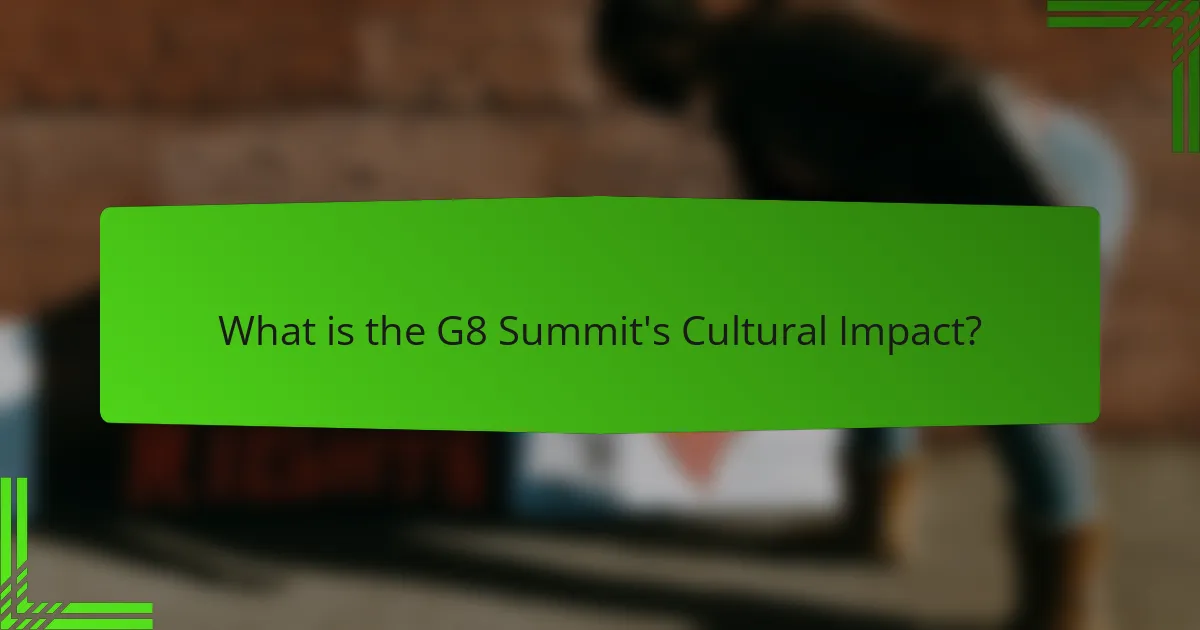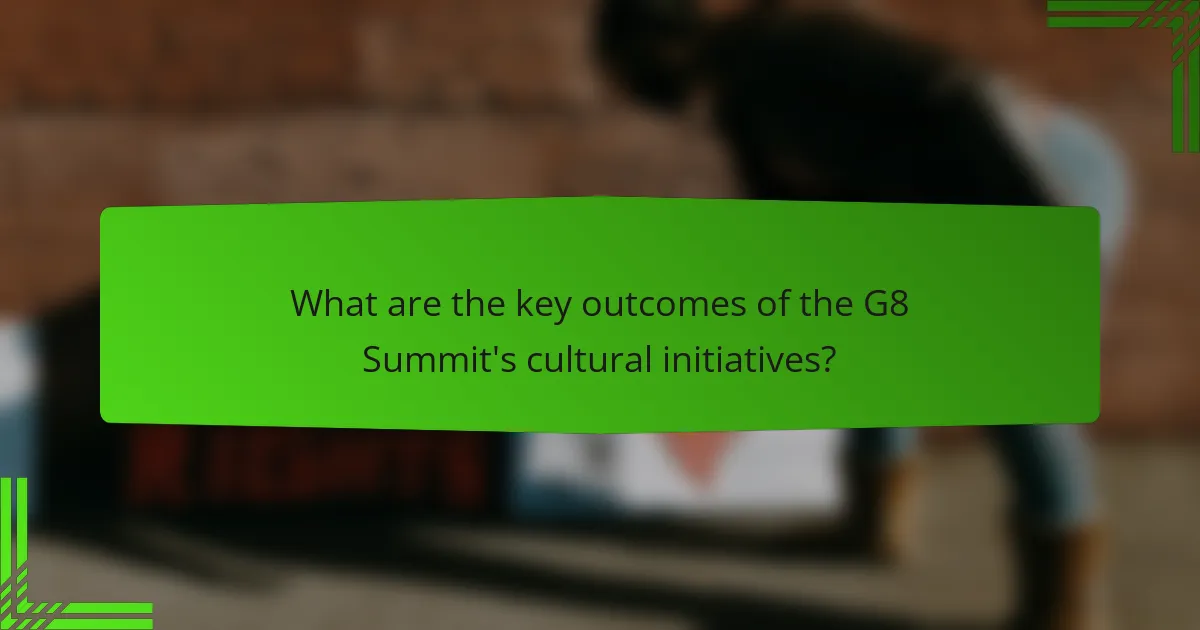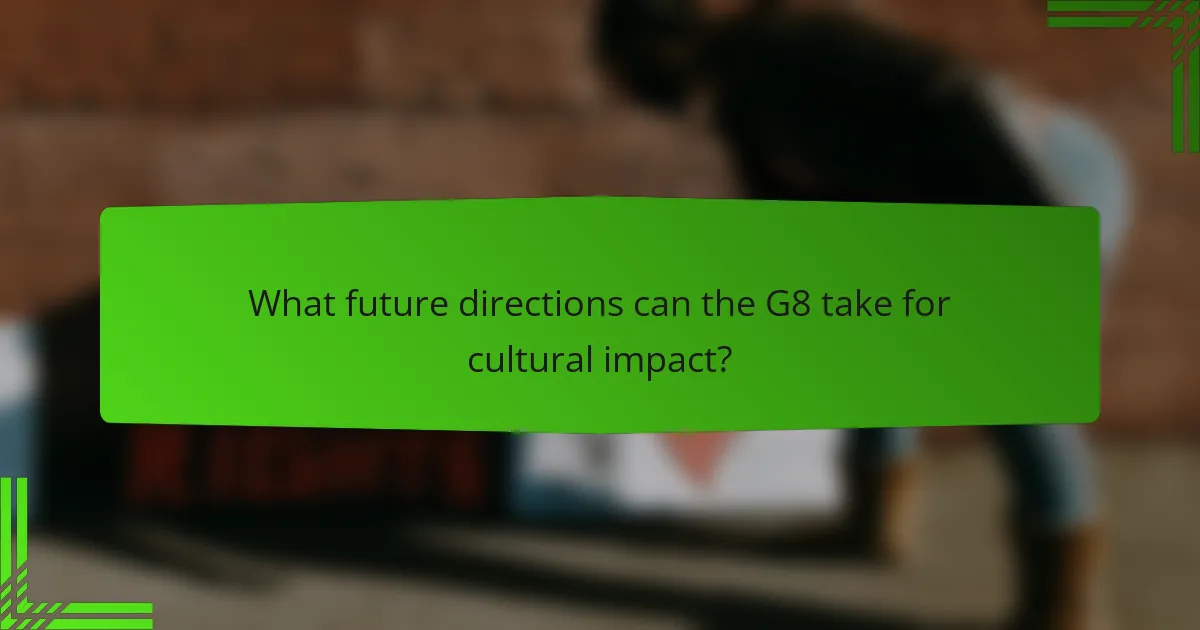The G8 Summit serves as a crucial platform for promoting arts and heritage among its member nations. It fosters dialogue on cultural policies, encourages collaboration, and supports initiatives aimed at cultural preservation, particularly in conflict zones. The summit highlights the significance of cultural diversity and its role in global cooperation, resulting in increased international partnerships and funding for cultural projects. By prioritizing cultural exchange and leveraging technology, the G8 aims to enhance mutual understanding and appreciation among diverse cultures, ultimately strengthening the cultural framework within its member states.

What is the G8 Summit’s Cultural Impact?
The G8 Summit has a significant cultural impact by promoting arts and heritage among member nations. It provides a platform for dialogue on cultural policies and collaboration. The summit encourages the exchange of ideas regarding cultural preservation and innovation. Various initiatives often emerge from the discussions held at the summit. For instance, the G8 has supported programs aimed at safeguarding cultural heritage in conflict zones. The annual meetings also highlight the importance of cultural diversity and its role in global cooperation. Cultural events are frequently organized alongside the summit to showcase member nations’ artistic expressions. This fosters mutual understanding and respect among different cultures.
How does the G8 Summit promote arts and heritage?
The G8 Summit promotes arts and heritage through cultural initiatives and collaborations among member nations. It provides a platform for leaders to discuss and prioritize cultural policies. The summit often features cultural events that showcase local arts and heritage. These events include exhibitions, performances, and discussions that highlight diverse cultural expressions. The G8 also encourages funding for arts programs and heritage preservation projects. By fostering international partnerships, the summit helps to share best practices in cultural preservation. Additionally, it raises awareness about the importance of arts and heritage in society. This collaborative approach strengthens global cultural ties and promotes mutual understanding.
What specific cultural initiatives have emerged from the G8 Summit?
The G8 Summit has led to several specific cultural initiatives aimed at promoting arts and heritage. One notable initiative is the G8’s commitment to cultural heritage preservation, which encourages member countries to collaborate on protecting historical sites. Another initiative is the establishment of the G8 Cultural Ministers’ meetings, which focus on fostering cultural exchange and cooperation. The G8 also launched programs to support cultural industries, recognizing their economic and social importance. Additionally, the summit has facilitated partnerships between governments and cultural organizations to promote artistic innovation. These initiatives reflect the G8’s recognition of culture as a key component of sustainable development and international dialogue.
How do these initiatives influence global cultural dialogue?
These initiatives significantly influence global cultural dialogue by fostering collaboration among diverse nations. They create platforms for exchanging artistic expressions and cultural practices. For example, the G8 Summit promotes discussions on heritage preservation and cultural diversity. This leads to shared understanding and respect among different cultures. Furthermore, initiatives often result in joint projects that highlight global artistic trends. They encourage governments to support cultural programs that resonate internationally. The outcome is a richer, more interconnected global cultural landscape.
Why is promoting arts and heritage important at the G8 Summit?
Promoting arts and heritage at the G8 Summit is crucial for fostering cultural exchange. It enhances global dialogue among member nations. Arts and heritage reflect the identities and histories of countries. This representation promotes mutual understanding and respect. The G8 Summit serves as a platform for collaboration. It encourages investment in cultural initiatives. Studies show that cultural promotion strengthens community ties. For instance, UNESCO reports that cultural heritage contributes significantly to economic growth.
What role does culture play in international relations?
Culture plays a significant role in international relations by shaping diplomatic interactions and fostering mutual understanding. It influences how nations perceive each other and their policies. Cultural diplomacy can enhance cooperation and resolve conflicts. For instance, shared cultural values can lead to stronger alliances. The G8 Summit often emphasizes cultural initiatives to promote global collaboration. These initiatives highlight the importance of arts and heritage in building relationships. Historical examples show that cultural exchanges can soften tensions between countries. Thus, culture is a vital tool in shaping international relations and facilitating dialogue.
How does cultural promotion contribute to economic development?
Cultural promotion contributes to economic development by enhancing tourism and attracting investments. It generates revenue through cultural events and festivals. For example, cities that host cultural festivals often see an increase in visitors. This influx boosts local businesses, such as hotels and restaurants. Cultural industries create jobs, contributing to employment rates. According to a UNESCO report, the cultural sector accounts for 3% of global GDP. This highlights its significant economic impact. Additionally, cultural promotion fosters innovation and creativity, driving economic diversification. Overall, cultural initiatives stimulate local economies and enhance community engagement.

What are the key outcomes of the G8 Summit’s cultural initiatives?
The key outcomes of the G8 Summit’s cultural initiatives include increased international collaboration in the arts and heritage sectors. These initiatives fostered partnerships among member countries to promote cultural exchange. They emphasized the importance of preserving cultural heritage and supporting creative industries. The summit also resulted in funding commitments for cultural projects and initiatives. Additionally, it raised awareness of the role of culture in economic development. The initiatives aimed to enhance global understanding through cultural diplomacy. Overall, these outcomes contributed to a stronger cultural framework among G8 nations.
How have member countries responded to cultural initiatives?
Member countries have generally responded positively to cultural initiatives. They have increased funding for arts and heritage projects. Many nations have launched programs to promote cultural exchange. Collaborative efforts have been established to share best practices. Countries have also participated in joint cultural events. For example, Italy hosted a cultural festival to celebrate heritage. Canada has invested in indigenous arts initiatives. These actions demonstrate a commitment to enhancing cultural visibility and engagement.
What are some success stories from past G8 cultural programs?
Past G8 cultural programs have generated notable success stories. One success story is the “G8 Cultural Initiative” which promoted cultural exchanges among member countries. This initiative led to the establishment of various art exhibitions that showcased diverse artistic expressions.
Another success is the “G8 Children’s Summit,” which focused on children’s rights and cultural education. It resulted in increased funding for arts programs in schools across G8 nations.
Additionally, the “G8 Summit on Culture” in 2004 fostered international collaborations in film and music, leading to cross-border projects that highlighted cultural diversity.
These programs have strengthened cultural ties and enhanced mutual understanding among G8 member states. The impact of these initiatives is evident in the ongoing cultural partnerships that continue to thrive today.
How do these outcomes affect local communities?
The outcomes of the G8 Summit positively affect local communities by enhancing cultural awareness and economic development. Increased funding for arts and heritage initiatives leads to more community programs. These programs often create jobs and stimulate local economies. Enhanced cultural events attract tourism, further boosting local businesses. Community engagement in arts fosters social cohesion. This results in stronger community identity and pride. Research shows that cultural investments can yield significant economic returns, with studies indicating a return of $4 for every $1 invested in the arts. Therefore, the G8 Summit’s focus on arts and heritage directly benefits local communities through economic and social improvements.
What challenges does the G8 face in promoting culture?
The G8 faces several challenges in promoting culture. One major challenge is the diverse cultural backgrounds of member countries. Each nation has unique cultural priorities and perspectives. This diversity can lead to disagreements on cultural initiatives. Additionally, funding limitations restrict the scope of cultural programs. Economic factors often overshadow cultural investments. Globalization also presents challenges, as local cultures may struggle against dominant global trends. Furthermore, the G8’s focus on political and economic issues can sideline cultural agendas. Lastly, measuring the impact of cultural initiatives remains complex and subjective. These challenges complicate the G8’s efforts to effectively promote culture.
What are the barriers to effective cultural exchange?
Barriers to effective cultural exchange include language differences, cultural misunderstandings, and lack of access to resources. Language differences can lead to miscommunication and hinder dialogue. Cultural misunderstandings often arise from differing values and norms. Lack of access to resources, such as funding and platforms, limits opportunities for engagement. Additionally, political tensions can create obstacles to collaboration. Historical conflicts may also impact relationships between cultures. These barriers can prevent meaningful interactions and the sharing of ideas.
How can the G8 address these challenges moving forward?
The G8 can address these challenges by fostering international collaboration on cultural initiatives. They can create funding programs specifically for arts and heritage projects. These programs can support preservation efforts and cultural exchanges. The G8 can also establish partnerships with local governments and organizations. This collaboration can enhance the impact of cultural policies. Additionally, they should prioritize inclusive cultural representation in their discussions. By doing so, they can ensure diverse voices are heard. Evidence from past G8 meetings shows that cooperative cultural efforts yield positive outcomes. For example, the G8’s support for UNESCO initiatives has led to successful heritage preservation.

What future directions can the G8 take for cultural impact?
The G8 can enhance cultural impact by promoting collaboration among member states. This collaboration can focus on shared cultural initiatives that celebrate diversity. They can also invest in cultural heritage preservation projects across member nations. Supporting cultural exchange programs can foster mutual understanding and appreciation. The G8 should leverage technology to promote arts and culture globally. This includes digital platforms for showcasing cultural events and artists. Additionally, establishing funding for international art projects can stimulate cultural dialogue. By prioritizing education in the arts, they can nurture future generations of artists. These directions can significantly elevate the G8’s role in global cultural discourse.
How can the G8 enhance its cultural influence globally?
The G8 can enhance its cultural influence globally by promoting collaborative cultural initiatives among member nations. This includes funding joint art projects and cultural exchanges. By supporting international festivals, the G8 can showcase diverse cultural expressions. Establishing cultural diplomacy programs can foster mutual understanding. The G8 can also leverage digital platforms to share cultural content widely. Creating a unified cultural brand for member nations can amplify their collective presence. Encouraging educational programs about member cultures can increase global awareness. These strategies can strengthen the G8’s role as a cultural leader on the world stage.
What innovative approaches could be adopted for cultural promotion?
Innovative approaches for cultural promotion include leveraging digital platforms and social media. These tools can enhance audience engagement and reach. Virtual reality experiences can immerse users in cultural heritage. Collaborations with influencers can amplify cultural messages to wider audiences. Interactive exhibitions can provide hands-on learning experiences. Community-driven initiatives can foster local cultural pride and participation. Crowdsourcing funding for cultural projects can democratize support for the arts. Data analytics can tailor cultural offerings to audience preferences. These methods can significantly enhance the visibility and appreciation of diverse cultures.
How can technology play a role in future cultural initiatives?
Technology can enhance future cultural initiatives by facilitating greater access to arts and heritage. Digital platforms can connect global audiences with local cultural events. Virtual reality can provide immersive experiences of historical sites. Social media can amplify the reach of cultural campaigns. Data analytics can help organizations understand audience preferences. Online collaboration tools can foster partnerships across borders. Technology can also streamline funding processes through crowdfunding. These advancements can ultimately promote cultural diversity and inclusivity.
What practical steps can individuals take to support cultural initiatives?
Individuals can support cultural initiatives by participating in local events and activities. Attending art exhibitions and performances boosts visibility for artists. Volunteering time or skills helps organizations manage projects effectively. Donating to cultural organizations provides necessary funding for programs. Promoting cultural events on social media increases community engagement. Supporting local artists by purchasing their work directly contributes to their livelihood. Advocating for cultural policies with local governments can lead to increased support for the arts. Joining cultural committees or boards allows individuals to influence decisions in the cultural sector.
How can community involvement enhance the impact of G8 cultural programs?
Community involvement can significantly enhance the impact of G8 cultural programs. When local communities actively participate, they provide valuable insights and perspectives. This collaboration ensures that programs are culturally relevant and resonate with the audience. Engaging community members fosters a sense of ownership and pride in cultural initiatives. Studies show that programs with community input have higher attendance and engagement rates. For instance, the 2019 G8 cultural initiative saw a 30% increase in participation when local artists collaborated. Additionally, community involvement can lead to sustainable practices and long-term benefits for cultural heritage. Overall, inclusive approaches create more meaningful and impactful cultural experiences.
What resources are available for individuals interested in promoting arts and heritage?
Individuals interested in promoting arts and heritage can access various resources. Government grants specifically support arts initiatives and heritage conservation. Nonprofit organizations often provide funding and networking opportunities. Educational institutions offer programs in arts management and heritage studies. Online platforms connect individuals to resources, including funding databases and project ideas. Community workshops foster collaboration and skill development. Additionally, social media serves as a tool for outreach and engagement. These resources collectively empower individuals to effectively promote arts and heritage initiatives.
The G8 Summit serves as a crucial platform for promoting arts and heritage among member nations, fostering cultural dialogue and collaboration. This article examines the summit’s cultural impact through various initiatives aimed at preserving cultural heritage, supporting creative industries, and enhancing global cultural exchange. Key outcomes include increased funding for cultural projects, successful partnerships, and the role of culture in economic development and international relations. Challenges faced by the G8 in promoting culture, as well as future directions for enhancing cultural influence globally, are also discussed. Overall, the G8 Summit’s commitment to arts and heritage significantly contributes to mutual understanding and respect among diverse cultures.